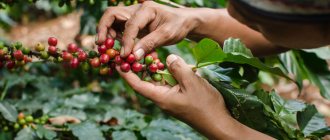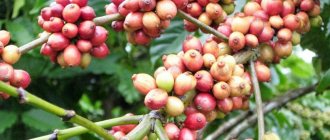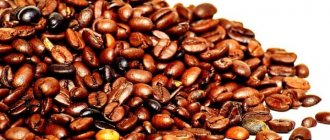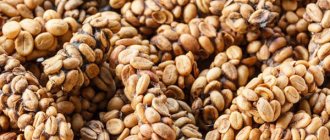Coffee is made from beans and therefore must be a vegetable, right? However, coffee beans grow inside the cherry, so maybe it's a fruit? It's a plant, so it must at least be one or the other.
So coffee is a vegetable? Technically speaking, coffee is a vegetable because it is an edible plant. However, for a more precise classification, coffee is, in particular, the seeds of the berry, that is, the fruit.
If you are an avid coffee drinker and want to know more information about it, then read on and learn how to properly classify coffee and much more in this short but very informative article.
Is coffee a fruit or a vegetable?
If you've ever drank coffee or made it for a happy loved one, you've probably heard of coffee beans .
Beans are vegetables. So, coffee should be vegetable?
Technically, any part of a plant that is used as food is considered a vegetable, so this is true. However, from both a botanical and a culinary perspective, most plant-based foods are further classified based on which plant they belong to.
First, beans are legumes, not just vegetables. But are coffee beans legumes? No. Although coffee beans are called “beans,” they are actually seeds.
To make sense of this debate, let's take a closer look at where exactly coffee begins.
Treatment
So, somehow we collected coffee cherries. The next step is to remove the coffee beans from them.
The structure of the coffee berry
The berry consists of 5 parts:
- Pulp
is the outermost shell of the berry. It is similar in structure and shape to cherries; coffee berries are also called coffee cherries. - Gluten (mucilage)
is a colorless jelly-like substance covering the patch. It contains a lot of sugars and because of this it is sticky to the touch. Sometimes it is confused with pulp, but it is easy to remember: pulp is colored, gluten is colorless. - Parchment (parchment shell)
is a hard shell around the grain. It protects the coffee bean from changes in humidity and the penetration of unnecessary substances into the grain. Therefore, it is usually removed immediately before the grain is exported - this process is called hulling (hulling). Sometimes confusion arises due to the fact that pament refers not only to the shell itself, but also to the grain together in it. - Silver skin
is a fragile film covering the coffee bean. They don’t take special care of it; when fried, it will turn into a husk. - The grain itself
. Typically, a coffee cherry contains two beans. If there is only one grain, it is called peaberry.
I tried to label the parts of the coffee cherry (I hope I didn't make a mistake):
Original photo by SFT-Trading sft-trading.ru/blog/573
To extract grain, you need to remove the pulp and gluten from it. In general, they can be removed with your fingers without any problems, but several tons of berries cannot be processed this way.
In fact, there is another intermediate method - honey, read about it in the article on the SFT-Trading website
Two different processing methods are used: dry and washed.
Dry processing method
The collected berries are laid out on a flat surface under the sun. For about a month they lie under the sun on special patios. During this time, the pulp becomes completely dry and is easily peeled off mechanically on drum machines. There is no need to worry about damaging the beans on these machines: as long as the coffee beans are green, they are very strong.
Dry processing video:
Washed processing method
Coffee is processed in three stages:
- Sorting
. The collected berries are first dipped into water for sorting. Ripe berries sink, berries of average quality remain floating in the middle, and unripe berries or berries with defects float. - Depulpation
. Sorted berries are cleared of pulp. The coffee bean in gluten is mechanically squeezed out of the pulp. Those who have ever prepared cherries for dumplings can imagine this process. - Fermentation
. After the coffee is cleared of pulp, the pachament (the grain in the gluten) goes into large tanks for fermentation. These tanks are filled with water containing bacteria. The grain stays in them for 36-72 hours, during which time bacteria eat the gluten on the grains. After this, the grain is washed.
Washed processing video:
Drying grain
The coffee beans obtained by any of the two methods must be dried. The grain is laid out on a patio in the sun or on African beds for 4-6 weeks. All this time it is tossed, loosened and turned over so that it dries evenly and does not rot. Drying ends when the moisture content in the grains decreases to 10-11%. The dried grain is placed in bags.
Depending on the processing method, it takes 1-2.5 months from picking the berries to receiving the grain ready for export.
Here's what drying grain looks like (all photos from fratellocoffee.com/coffee-drying-speeds:
How dry and washed processing affect taste
With the dry processing method, during drying the berries begin to ferment, juice and sugar from the pulp penetrate into the grain. Coffee brewed from such beans turns out sweeter, with a slight aroma of stale berries or fruits.
With the washed processing method, depulpation and fermentation occur quickly, within 2-3 days. During this time, sugar from the pulp does not have time to penetrate into the grain. Coffee from such beans is purer, with a more pronounced natural sourness.
"Natural" processing method
Historically, the dry processing method was also called “natural”. This does not mean that the washed one is somehow bad, that terrible chemicals or herbicides are used there. Most likely, the dry method simply appeared first.
If a store or coffee shop sells both dry-processed and washed-processed coffee from a single farm, it will usually add “dry” or the abbreviated “nat” to the name to differentiate them. See:
Designation of washed and dry coffee in the torrefacto store
Designation of washed and dry coffee in the tastycoffee store
Remember about coffee processing
There are two processing methods: dry and washed. Dry is sweeter, washed is cleaner, more acidic. Dry-processed coffee is labeled in stores as “dry,” “nat,” or “naturally processed.”
Where do coffee beans come from?
We know that money doesn't grow on trees, but coffee is just as valuable to many of us, and it does grow on trees. In particular, coffee grows on shrubs native to tropical Africa and Asia.
There are over 1,200 species of Coffea plants, but not all of them produce the beans we turn into our caffeinated drinks.
Coffee is considered the most valuable commodity in the world, as well as the most traded.
Coffee is now grown virtually all over the world, and popular coffee regions include most of the Americas, even parts of the United States, as well as extended regions of Africa and Asia.
Some of the largest coffee producers and exporters include Indonesia, Vietnam, Ethiopia, Kenya, Rwanda, Honduras, Guatemala, Costa Rica, Colombia and Brazil , but many more countries regularly produce our favorite "bean."
general description
The Coffee genus has about 90 species of evergreen plants, among which you can find both large shrubs and spreading trees reaching 8 meters in height and above.
All species are united by one common feature - the presence of caffeine in fruits and foliage.
So where is the birthplace of the coffee tree? The homeland of the plant is considered to be the province of Kaffa in Ethiopia, where they first began to drink the coffee drink, which later gained worldwide popularity.
Coffee is found naturally in Asia and Africa. It is cultivated in almost all countries with a favorable tropical climate. In which countries is coffee grown? The largest plantations of the famous plant are located in Brazil, India and Sri Lanka.
In indoor conditions, coffee is a compact tree no more than one and a half meters in height. Its branches grow in a horizontal direction, forming almost symmetrical tiers. This makes it easy to create an attractive standard tree shape with a dense crown.
Large dark green coffee leaves are arranged oppositely on the stems. The foliage shape is oblong elliptical or lanceolate with wavy edges and a pointed tip. The leathery surface of the leaves of the coffee tree has a beautiful glossy sheen.
The tree blooms with small cream or white five-petaled flowers, collected 4-7 pieces in dense bunches-inflorescences. Flowers bloom in the axils of leaves on annual shoots. They exude a very pleasant aroma, reminiscent of jasmine. The flowers remain in the bud stage for about a month and only then bloom. The plant begins to bloom and bear fruit in the third year of life.
After flowering, the fruits of the coffee tree appear in the form of first yellow-green, and then, as they ripen, reddish berries with a diameter of about 1.5 cm. In appearance and color, they are similar to cherry fruits, but with a more elongated shape.
Coffee derava berries grow on very short stalks and are located on the branches in groups close to each other. Under the thick skin of the fruit you can find sweet and sour pulp and two coffee grains, closely pressed together with their flat bases. The ripening of the fruits of the plant lasts from 4 to 6 months.
One adult tree grown on a plantation produces up to 3 kg of grains per year. Under indoor conditions, almost 500 g of fruit can be collected from a tree over the same period. The collected ripe berries are withered for several days, then the skin is removed and dried in a ventilated room or in the fresh air under a canopy.
For your attention, a coffee tree - photo of the fruits:
Only a few coffee trees are grown at home, among them the following types are popular:
What is green coffee?
Under normal circumstances, you cannot juice coffee beans, only fruit. Roasted coffee beans contain less than 2% water, so it would take a huge amount of beans to create even an ounce of juice.
However, green coffee beans much more water , up to 55%, because they have not yet been roasted. This is how you can make juice from green coffee beans. However, this is not how green coffee is typically made or consumed.
Green coffee can be hot water flavoring powder an extract . It can also be used as a supplement, in extract or tablet form.
One way to make green coffee is to soak green coffee beans in water to release the caffeine and other nutrients. It is then turned into a highly concentrated extract . You can also soak green beans for at least 8 hours, then boil and strain.
More often, unroasted beans are ground into a fine powder . This powder can be packed into something like a tea bag or added directly to hot water and then strained through an ultra-fine sieve.
The powder does not dissolve like instant coffee, but remains chalky in water unless removed.
The taste is not like the coffee we are used to, as the taste mainly develops during the roasting process. Green coffee is smooth and refreshing, with a somewhat woody, earthy flavor that is closer to an herbal tea than a regular cup of coffee.
Green coffee, although very different from traditional coffee, is still considered the seed used to make an infusion, although it can also be an extract.
Grain composition
Raw green grains have a richer composition than roasted ones. It contains about 2 thousand substances from proteins, fats and carbohydrates, to esters and acids. One of its most valuable components is caffeine, which gives the drink its invigorating effect and bitter taste. Arabica has less caffeine than Robusta. Today this substance is synthesized in laboratories and is a component of many medicines. Unroasted beans contain less caffeine than cooked beans.
You can estimate the grain size of two different types of coffee by eye.
The next most important components of coffee are chlorogenic acid, tannin, organic acids and minerals. Chlorogenic acid has earned popularity among those who want to lose weight due to its fat-burning properties and ability to speed up the metabolism of fats and carbohydrates. There is more of it in green coffee than in roasted coffee.
Tannin is a substance that not only stimulates the nervous system, but also adds flavor to the drink. The lower the tannin content in the grain, the more bland and tasteless the drink itself will be. Like chlorogenic acid, tannins are partially released during roasting.
Coffee contains potassium, calcium, iron, manganese, vitamins B and PP. Among the organic acids found in it are malic, oxalic, citric and acetic. The acidity of coffee increases with prolonged storage.
The coffee bean consists of 3/4 water, fiber and coffee oil and only 1 part belongs to the above and other components, including fats, proteins and carbohydrates. When roasting grain, the task is to rid it of liquid, release essential oils and evaporate some of the tannin and chlorogenic acid.
Can I eat raw and roasted coffee beans? It is not forbidden, but also not recommended. Both green and black grains have a hard shell; chewing it can damage tooth enamel and turn it yellowish. The eaten grain does not cause any harm to health, but it also has significant benefits. Some chew grains to get rid of bad breath and to kill pathogens in the mouth.
In the east, they not only tell fortunes on coffee grounds, but also drink them
Others prefer to eat the brew itself after a cup of coffee, arguing that it cleanses the intestinal walls of food debris and toxins, and also acts as a laxative. This is how coffee is consumed in the east, along with grounds. It is she who has a wider range of use cases. This is for external use as a scrub or component of face and hair masks. And a completely innovative approach to using coffee is to process it into fiber for clothing. What else progress will come up with regarding coffee is unknown, but even after a thousand years no one will refuse it as an ingredient for a drink!
Benefits of Coffee
Now that we've established that coffee, which is technically a vegetable in a very broad sense, is, more accurately, a seed, it's time to decide whether it has the benefits we've come to associate with plant foods.
The seeds are generally praised for their high content of healthy fats. The roasting process burns off any noticeable healthy fats, so that's not the benefit, although there is a lot of it.
Most coffee drinkers value the caffeine content of their hot drinks. Caffeine is not only a natural stimulant, but also a psychoactive substance. This means that it activates adrenaline and norepinephrine, hormones responsible for brain function and physical performance.
It is also considered a very effective fat burner and can improve your metabolism, helping you maintain a healthy body weight when taken as part of a healthy lifestyle.
Many people fear that caffeine will increase blood pressure and cause heart problems due to the stimulation; however, research shows the opposite. Coffee drinkers have a lower risk of developing heart disease and/or stroke than non-coffee drinkers or even decaffeinated coffee drinkers.
In addition to caffeine, coffee also contains many vitamins and minerals.
Even though coffee isn't your stereotypical vegetable, it still has many impressive health benefits.
Types of coffee drinks
What is espresso?
The basis of all coffee drinks is a drink called espresso. Espresso is prepared by flowing hot water under pressure (about 90°) through a filter with ground coffee. This is why it is called “espresso”, which means “squeezed” in Italian.
All coffee drinks are based on espresso and by adding milk, cream, ice cream, chocolate, whiskey or even lemon juice we get various delicious coffee drinks.
Related questions
Is cocoa a vegetable?
Like coffee, chocolate is obtained from beans, or more precisely, cocoa beans. Just like coffee, these beans are not true beans or legumes, but rather cocoa beans are the seeds of the fruit of the cocoa tree.
Are cherries a fruit or a vegetable?
Cherry is a fruit. Although, more precisely , these are drupes, a fancy name for stone fruits.
Drupes are fruits that have a single seed or stone surrounded by fleshy pulp and a thin skin . Peaches, plums and olives are also pitted.
Collection of coffee berries
One of the first steps in coffee's journey into your cup is picking the coffee cherry. There are several types of it. The simplest is machine collection . Special equipment shakes the coffee trees until all the berries fall. Thus, in addition to ripe berries, unripe and overripe ones fall. After harvesting, they are sorted: knots, leaves and unsuitable berries are removed. The production of such coffee is characterized by minimal costs, but this has an extremely negative impact on the quality of the product.
A more gentle way to collect berries for coffee trees is strip picking. It is typically used in areas where machine collection is ineffective (eg mountainous areas). Its essence is to manually remove all the berries from the branch at once. Again, ripe and unripe at the same time.
The highest quality way to collect coffee berries is by hand picking, or hand picking . Pickers collect only ripe berries, and carefully leave the rest on the branches. Coffee collected this way is much tastier, even if it costs more.
From berry to cup
There are two main botanical types of coffee trees: Arabica and Robusta. Arabica has a greater variety of flavors, while Robusta has more caffeine. We wrote about this in our article “What is the strongest coffee?” The share of Arabica in world production is 85-90%, Robusta - 10-15%. Coffee varieties are determined by the country of origin. For more information about the naming of varieties, see the article “Coffee varieties - sorted out on the shelves.”
Brazil. Young coffee trees
Coffee is frost-resistant and grows in countries with tropical climates. The coffee belt is bounded by the Tropic of Cancer to the north and the Tropic of Capricorn to the south. The ideal temperature for Arabica is 15-24 degrees Celsius, for Robusta - 24-30 degrees. The altitude of Arabica grows from 700 to 2300 meters above sea level, for Robusta - from 200 to 800 meters, although some Robusta grows higher, for example Uganda Robusta (1200 m).
The coffee tree can reach a height of 10-15 meters. However, trees on plantations are rarely taller than 3-4 meters, to facilitate harvesting. The lifespan of a coffee tree is up to 60 years, but it bears fruit only for 15-20 years, so plantings in the countries of origin are regularly renewed. The coffee tree begins to bear fruit at the age of three to four years. First the tree blooms. Not everyone realizes how beautiful coffee flowers are. Snowy white in color, they look like feathers of snow in sultry tropical climates. After a few days, the flower dries and coffee berries appear in its place.
Nicaragua: green coffee cherries
The coffee tree blooms continuously, and due to this, unripe (green), ripe (yellow or red), and overripe (dark yellow, dark red or black) berries can hang on the tree branch at the same time. The yellow or red color of ripe coffee cherries depends on the specific type of coffee.
It's not easy to say which month the coffee harvest occurs in, since coffee on Earth actually blooms all year round. In Brazil, for example, the harvest occurs from April to September, in Ethiopia from October to December, in Costa Rica from September to January, in Malawi from December to February, etc. The coffee year, by the way, begins on October 1 and ends on September 30.
Harvesting is carried out differently in different countries. The ideal case, of course, is to manually collect only ripe berries, leaving unripe berries on the branch, which are collected the next time. This method, which many people have heard about thanks to advertising, is actually not used very often, since the speed of such collection is very low. What is more often used is the so-called “stripping” - when all the berries hanging on them are torn from the branches, which are subsequently sorted at a processing station. Mechanical harvesting using special combines is not a very common phenomenon in the coffee world, since coffee often grows on fairly steep mountain slopes, where the passage of agricultural machinery is seriously difficult. The most mechanized country in terms of harvesting is Brazil.
Nicaragua: ripe red coffee berries
Due to the use of combines and stripping, unripe and overripe berries are also collected. The next stage is harvest consolidation. Many people naively believe that everyone works directly with the plantations or buys coffee on the exchange. This occurs in an extremely limited number of cases that can be counted on one hand. Basically, the pattern of coffee exports from the country of origin looks different. Let's say there is a small farmer in the country of origin who produces ten tons of coffee annually. The farmer has harvested the harvest. Where should he put it? He cannot carry out the “washed” processing (about which below) on his own. The attitude towards such “own processing” in the coffee world is negative. For example, coffee from Africa, which the farmer carried out the washing process himself, is called “washed”. Coffee that has been processed in Africa at special processing stations (wet mill) is called “fully washed” and is valued much higher.
However, more about coffee processing itself a little later. Our farmer, who has harvested ten tons of coffee (it’s another question, ten tons of berries or ten tons of beans), has no choice but to either hand over the coffee to a wet mill station or carry out dry processing on his own. Be that as it may, as a result, the farmer will still have to sell his coffee to an exporter, because he will not physically be able to organize the entire logistics chain for delivering coffee from his farm to the loading port and from there to the final recipient. The farmer will not be able to make payments to the recipient, since most of them know nothing about the global banking system. The exporter sells the coffee to a large international trader, who, in turn, sells the coffee to an importing company or to a large roaster in the country of consumption who imports it themselves. In this case, the exporter will handle the shipment from the country of origin, and the guarantee of coffee delivery to the destination will be provided by an international company.
Nicaragua: ripe yellow coffee berries
At the same time, work directly with plantations is indeed carried out, but the number of such cases can be counted on one hand. This is true of Brazil, with its huge plantations that have a worldwide reputation. This is also true if the roaster has its own plantation in the country of origin, which is not often the case. Finally, this is true when we are talking about micro lots (fifteen, twenty bags) of ultra-high quality. In all other cases, the work proceeds according to the scheme proposed above, possibly with minor deviations.
Be that as it may, especially when it comes to the so-called washed Arabica, before export, the coffee in any case first passes through a processing station. There are two types of processing stations - a wet mill station and a dry mill station. In general, there is still confusion with the terminology. Let’s make it clear once and for all: coffee undergoes either washed or natural (dry) processing. Moreover, in Russian this is most often the case: “washed” in this context is contrasted with “natural”. The origins of this terminology are very simple. In English, coffee is either dry processed (natural processing) or wet processed (washed processing). Dry processed coffee gives us natural coffee, and wet processed coffee gives us washed coffee. But in fact, the main thing is to understand the essence of these concepts. With natural processing, coffee berries are simply dried in the sun as is, in the peel. Washed processing involves the use of water to sort and process the berries. Let's look at these methods in more detail.
Brazil: Small farmer produces organic coffee
There are two main ways of processing coffee in the country where it grows - natural (natural, or dry, dry) and washed (wet, also wet). In natural processing, coffee cherries are dried on concrete, clay patios, or simply on the ground. Naturally processed coffee has a bright and intense taste, good richness and increased sweetness, but often acquires a fermented aftertaste, which not everyone likes. Additionally, if coffee is dried on the ground rather than on a patio, it can develop an earthy flavor—a flavor defect. While the complexity and fullness of flavor of naturally processed coffee is well known, washed coffee is more prized around the world. This is due to the fact that farmers most often go for natural processing not because of an internal inclination towards the richness and richness of the taste of the resulting coffee, but because of the inability to transfer the coffee to the washed processing station in a timely manner. Accordingly, the attitude towards quality is lame. If, with this method, all technological processing conditions are observed, then the quality of the resulting coffee will be excellent and it will be no worse than washed-processed coffee. In general, natural processing is most often used in those countries where it is dry during the harvest and there are long periods without precipitation. These are Yemen, Brazil, Ethiopia, Indonesia. It is because of the natural processing that we have added Yemen to the list of varieties we offer. The main technological feature of natural processing is, of course, the long-term contact of the grain with the very sweet skin of the coffee berry, which occurs during this process.
Brazil: washed coffee production, coffee processing station
During washed processing, coffee beans are peeled (depulped) and placed in special water tanks, where they are kept until the gluten leaves the grain. In addition, placing coffee in water removes defective beans, such as the well-known "floaters" - empty beans of extremely low density that float in the water. These "floats", if they do reach the fryer, turn into small black coals as a result of frying. In addition, special devices allow you to sort unripe grains. At the end of the washed processing process, the coffee beans are dried in the same way as in the case of natural processing, either in the sun or using mechanical dryers.
Washed coffee is often better balanced and smoother than naturally processed coffee. Washed processing, unlike natural processing, enhances sourness rather than sweetness. Another characteristic of washed coffee is, of course, a clean, “transparent” cup with less richness than in the case of naturally processed coffee. Since washed processing enhances the acidity, in those countries where coffee is famous for its interesting and unique acidity, washed processing is used much more often. You can read more about the meaning of sourness in our article “Sour Coffee”. In addition, washed processing helps to process coffee in countries where the harvest falls during the rainy season, and drying coffee in the sun for a long period of time is not possible. Both washed and natural coffee can be purchased in our store.
Brazil: Black berries are removed during coffee processing
In general, the question of choosing natural or washed coffee depends on each consumer. For example, I personally prefer natural coffee. I like its wildness, riot of taste, uncontrollable taste contradictions and wonderful richness. Moreover, the stronger these signs are expressed in coffee, the better. Plus, I like the idea of sun-drying coffee, which has something traditional in it. Finally, I believe that naturally processed coffee is completely undeservedly treated as second-class coffee by some not entirely knowledgeable consumers and even specialists.
The majority of coffee produced in the world, of course, goes through the washed process. It is all the more interesting to try natural varieties from countries that traditionally produce washed coffee. In the summer of 2011, I was in London and at the absolutely wonderful Monmouth coffee shop I drank natural coffee from Costa Rica, all of whose mass production is based on the washed process. It was amazing coffee.
Nicaragua: Coffee being prepared for export
Ultimately, having a choice between washed and natural coffee ultimately makes the palette of coffee flavors richer, and accordingly is an advantage of coffee as a drink.
After processing, the coffee is dried and bagged before export. Sometimes the manufacturer additionally ages the coffee in special silos so that the beans acquire the required flavor profile. This happens, for example, in Brazil.
Jute bags are predominantly used for export from origin countries. Depending on the country of origin, the bags have different weights, which are 69 kilograms for Central American countries, 70 kilograms for Colombia, 60 kilograms for Brazil, African and Asian countries. The weight of a bag of expensive coffee can be arbitrary: for example, coffee from the Galapagos Islands can be supplied in twenty-five kilogram bags, Yemeni coffee - in twenty kilogram bags, Jamaica Blue Mountain - in fifteen kilogram barrels, New Caledonia - in bags weighing 10 kilograms, etc.
Just before shipment from the country of origin, the exporter orders a container from the shipping line and places bags of green coffee in it. Twenty-foot containers with a total weight of about 20 tons are usually used. In addition to jute, other materials are also used, such as polypropylene.
Italy: coffee roasting on a large industrial roaster
In the country of consumption, the bags go to the roaster, who roasts the coffee beans. We have dedicated a separate article to this issue - “Roasting Coffee”. Coffee roasting is an interesting and very important profession for a coffee gourmet. The main pitfall of coffee roasting is that not only each variety, but also each machine behaves differently when roasting. That is, in addition to the fact that the roaster needs to constantly look for the ideal roasting profile for each type of coffee, he also needs to remember that the behavior of each roaster - coffee roasting machine - is individual. Accordingly, it is impossible to read some book on roasting and suddenly learn how to roast everything. No, the roaster has to learn how to roast coffee strictly empirically, through experience, taking into account such indicators as the density of the bean (i.e. the height of growth) and the flavor profile of the coffee.
The main interest of coffee consumers in the process of roasting is due to the fact that roasting radically affects the taste of the final drink. The lighter the coffee is roasted, the higher its acidity. Accordingly, if we take any sour coffee, for example Ethiopian Irga Cheffe or Kenya, and give it a dark roast, this variety will lose the unique characteristics of its sourness. By and large, such a unique result can no longer be called by the name of this variety, because, in fact, it will be a different coffee.
Russia: Torrefacto coffee roasting
Roasting must take place in the country of consumption, in close proximity to the coffee consumer. Moreover, for Russia, for example, with its enormous size, coffee roasting for a Barnaul consumer should take place in Barnaul, and for a consumer from Vladivostok - in Vladivostok. The fact is that coffee has a fantastic aroma and incredible taste within a very short time after roasting - about two weeks. You can find out how the aroma of coffee and the freshness of its roast are related in our article “The Phantom Aroma of Coffee.” I call coffee that was roasted no more than two weeks ago freshly roasted. I drink this coffee myself and recommend it to you. The next stage is from two weeks to two months, when coffee slowly loses its taste and aroma characteristics. This is no longer freshly roasted coffee, but it is still a “B” coffee and you can drink it. Coffee that has been roasted for more than two months is already a C grade coffee. Four months after roasting, you can safely throw away the coffee - it develops a characteristic musty-rancid smell, which is also reflected in the taste. In general, roast freshness is one of the main components of coffee quality. However, it is in relation to the freshness of the roast that the greatest number of oversights and omissions occur. There are many coffee roasting companies in Russia, many of which operate at a high professional level, but the freshness of roasting coffee sold in stores leaves much to be desired.
It is best to store roasted coffee in a paper or foil bag with a valve. And it’s even better not to store it at all, but to drink it. Making coffee is a process that does not require special preparation, unless, of course, professional coffee machines are used for this. Specially trained people - baristas - prepare coffee on professional coffee machines. The profession of a barista is not easy and is not as straightforward as it seems at first glance. Good barista hands can squeeze out a good cup of espresso from even average coffee, but a bad barista can ruin even the best coffee. As a result, we get that the taste characteristics of a cup of coffee are made up of three components - the coffee itself, the professionalism of the roaster and barista. This makes it much more difficult to evaluate the taste characteristics of coffee and makes it difficult for consumers to obtain quality coffee. Another big challenge with quality coffee is the roast date, as the flavor profile of coffee deteriorates dramatically over time, as we noted above.
Germany: Valentina Kazachkova becomes world champion in cap testing
In the professional coffee community, there is a special procedure for assessing the taste parameters of a particular variety, which is called cupping (from English to cup - professionally tasting coffee). I wrote more about the procedure for cupping, which can easily be arranged at home, in our article “What is cupping?” For cupping, only freshly roasted coffee is used, which is natural and typical. Cupping evaluates aroma, taste, flavor uniformity, and its consistency with the overall flavor profile for a given variety.
Cupping championships are regularly held around the world, during which the participant is offered eight stations of three glasses each. Two out of three glasses contain the same coffee. The capper's task is to determine the third glass for each station.
The winner of the 2009 World Cap Testing Championship in Cologne (Germany) was our compatriot Valentina Kazachkova, a leading technologist at the Russian company. Therefore, stories that in Russia they do not know how to roast coffee, do not know how to evaluate it correctly and do not understand this issue at all - this is nothing more than a fiction, which sellers of imported roasted coffee most often resort to in order to more successfully sell their stale goods . Fortunately, the facts speak for themselves. Our compatriot Philip Leites also became the world champion in the category of coffee and alcohol in 2011.











